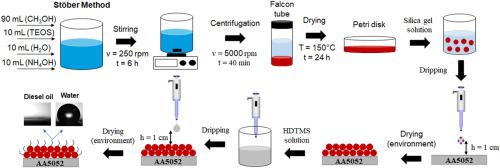Study of a fluorine-free silane-based film on an aluminum alloy via drop-coating method with the purpose of providing hydrophobic and corrosion protection properties
IF 4.3
3区 材料科学
Q2 MATERIALS SCIENCE, MULTIDISCIPLINARY
引用次数: 0
Abstract
This work sought to developed a fluorine-free, water-repellent silane-based film on 5052 aluminum alloy by studying the incorporation of Hexadecyltrimethoxysilane (HDTMS) into or over the silica gel film to protect against corrosion in a saline environment. Additionally, the interface of the silane-based film was studied using liquids such as soybean oil, diesel oil, and lubricating oil. Silica gel particles were deposited by dripping a solution of silica gel using design of experiment approach. The porosity of the silica gel film was assessed employing the potentiodynamic polarization technique. The condition of the more cohesive silica gel film was chemically modified by dripping a low concentration solution of HDTMS. The functionalized film on the aluminum alloy exhibited a contact angle of 136°, oleophilic behavior for soybean oil and lubricating oil, and superoleophilic character for diesel oil. Notably, hydrophobic film exhibited chemical (acid, alkaline, saline) and thermal stabilities (50–150 °C). The protective effect of the functionalized film against corrosion ions was confirmed by Electrochemical Impedance Spectroscopy in a saline solution over 7 days. These results suggest a fluorine-free alternative approach for thin film development and the study of its multifunctionality, including enhanced corrosion resistance, water-diesel oil separation, and potential applications in anti-fouling.

研究通过滴涂法在铝合金上形成无氟硅烷薄膜,以提供疏水和防腐蚀性能
这项研究试图通过研究在硅胶膜中或硅胶膜上加入十六烷基三甲氧基硅烷 (HDTMS),在 5052 铝合金上开发一种无氟、憎水的硅烷基薄膜,以防止在盐水环境中受到腐蚀。此外,还使用大豆油、柴油和润滑油等液体对硅烷基薄膜的界面进行了研究。采用实验设计法,通过滴入硅胶溶液沉积硅胶颗粒。采用电位极化技术评估了硅胶膜的孔隙率。通过滴入低浓度的 HDTMS 溶液,对更具内聚力的硅胶膜的条件进行了化学修饰。铝合金上的功能化薄膜的接触角为 136°,对豆油和润滑油具有亲油性,对柴油具有超亲油性。值得注意的是,疏水性薄膜具有化学稳定性(酸、碱、盐水)和热稳定性(50-150 °C)。电化学阻抗光谱法证实了功能化薄膜在盐溶液中 7 天对腐蚀离子的保护作用。这些结果为薄膜的开发和多功能性研究提供了一种无氟替代方法,包括增强耐腐蚀性、水-柴油分离以及在防污方面的潜在应用。
本文章由计算机程序翻译,如有差异,请以英文原文为准。
求助全文
约1分钟内获得全文
求助全文
来源期刊

Materials Chemistry and Physics
工程技术-材料科学:综合
CiteScore
8.70
自引率
4.30%
发文量
1515
审稿时长
69 days
期刊介绍:
Materials Chemistry and Physics is devoted to short communications, full-length research papers and feature articles on interrelationships among structure, properties, processing and performance of materials. The Editors welcome manuscripts on thin films, surface and interface science, materials degradation and reliability, metallurgy, semiconductors and optoelectronic materials, fine ceramics, magnetics, superconductors, specialty polymers, nano-materials and composite materials.
 求助内容:
求助内容: 应助结果提醒方式:
应助结果提醒方式:


